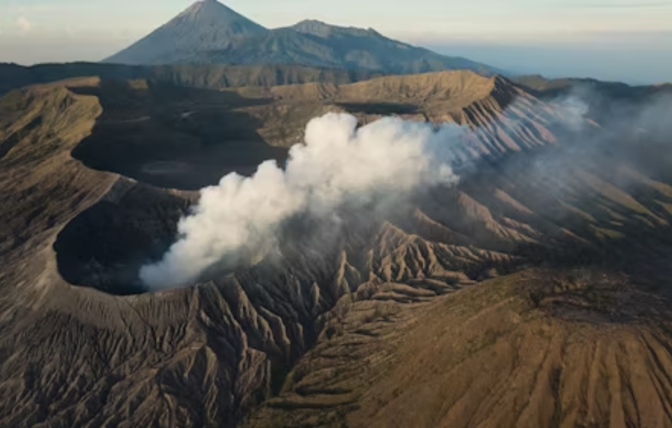

Current intense eruptions of Mount Lewotobi have impacted Indonesia travel significantly by belching enormous ash clouds up to six thousand meters, prompting aviation authorities to issue the utmost-level red alert on the safety of aircraft. The dense ash plumes threaten flights by crippling engines and disturbing flight paths, prompting airlines to divert or suspend flights across East Nusa Tenggara. Apart from this, the government also imposed a six-kilometer radius exclusion zone near the volcano to shield surrounding populations from the threat of ash fall, as well as from potential lahars, making travel plans difficult and security in the area challenging.
Mount Lewotabi Erupts Violently in Indonesia Issues Highest Aviation Alert
Indonesia's East Nusa Tenggara province Mount Lewotobi erupted in a series of blasting eruptions today emitting massive plumes of volcanic ash into the air, prompting aviation authorities to warn of their most critical alert. The blasting eruptions presented grave concerns regarding air traffic safety as well as residents who reside near the volcano.
Its largest eruption was observed by Volcanology and Geological Disaster Mitigation Center (PVMBG) at approximately 2:05 local time. It erupted with ash columns of six thousand meters (about twenty thousand feet) above the volcano's summit, releasing dense gray haze on local skies. There were enormous ash clouds in every direction—north, northeast, west, and northwest—that were unchanging in character, releasing high flight hazards around the region.
To counter this rise, the Volcano Observatory Notice for Aviation (VONA) also issued an automated red level aviation warning, its most critical. The warning specifically warns airlines and pilots against flight under the six-thousand-meter altitude above Mount Lewotobi to avoid collision with volcanic ash that will largely damage airplane equipment and engines. These ash clouds in the air have resulted in engine failure, impaired vision, and disruption of flight timetabling till now in the whole world, and therefore this is a reason of the highest concern from the safety point of view.
Ashfall eruption is all aviation hazards. Indonesian authorities also established a six-kilometer buffer zone around the volcano crater to protect the residents and visitors. This closed area keeps the site most vulnerable to the hazards of volcanic eruptions, such as falling ash, pyroclastic flow, and possible ground instability, off-limits. People living at the boundary of the closed area have been directed to comply with evacuation orders and refrain from moving into risk areas until normalcy is restored.
But another very perilous risk on officials' lists is the risk of lahars—rapidly moving mudflows of volcanic origin along slopes—produced as rainwater commingles with loose volcanic debris and ash on volcanoes' slopes. The erosive currents even travel down river valleys even more quickly and pose a threat to downstream villages and structures. With the rainy season looming over the region, the primary threat of the mudflows is greatly augmented, and more alert statuses have to be upheld by units of disaster relief.
Local disaster authorities are still in a state of high alert, keeping watch over seismicity and gas emission from Mount Lewotobi. Seismographs and lookout posts are placed to track the explosivity of eruptions to obtain early warnings for fresh eruption surges or second disaster. Communication among the geology personnel, emergency teams, and government persists to safeguard the public and act quickly in case of increasing danger.
Mount Lewotobi is situated in Indonesia's extensive volcanic arc of the Pacific Ring of Fire, which is an area with vast volcanism and earthquakes. Indonesia hosts a dozen or so active erupting volcanoes and is considered one of the most volcanically active nations on the planet. Monitoring and preparedness will be necessary to reduce their effects on people, highways, and air traffic.
The latest eruption is just the newest in the long-time hardships of East Nusa Tenggara province, an area usually plagued by natural calamities in the forms of earthquakes and volcanoes. It has become accustomed to such disasters, but with every subsequent eruption are added the fresh perils of the ability to interfere with livelihoods, burn crops, and drain out emergency budget.
Since the region is overlaid by extensive volcanic ash cover, people should use eyewear and masks to avoid eye and respiratory tract irritation. Pollution of water bodies, soil equipment, and road surface coating by ash fall is another danger to infested regions. Public announcements by the authorities caution people to remain indoors when there is heavy ash fall and close clean water sources to be used for drinking purposes.
The air travel industry is closely monitoring the eruption of Mount Lewotobi volcano and respective modifications to flight schedules and routes wherever required to enable safe carriage of passengers. Indonesian domestic flights flying within national jurisdiction and local international flights flying in the region adjoining the country are suggested to remain closely updated with respect to official volcanological activity reports and also liaise with air traffic control centers.
Mount Lewotobi’s powerful eruption has triggered the highest aviation alert in Indonesia, disrupting travel due to dangerous ash clouds that threaten flight safety and local communities. The volcanic activity forces flight restrictions and exclusion zones, significantly affecting Indonesia travel in East Nusa Tenggara.
The recurrent eruptions of Mount Lewotobi today only add to the testimony that Indonesia is still vulnerable to volcano danger. With ash clouds at record levels, and an aviation highest warning already in effect, surrounding communities and the world of aviation are made even more vulnerable. Increased vigilance, community preparedness, and rapid emergency response are still necessary as this ever-present volcanic action continues unfolding.

